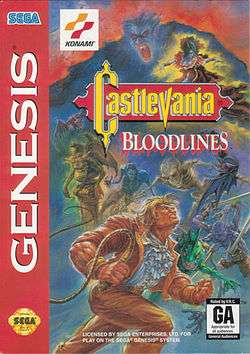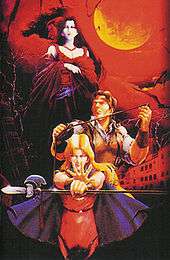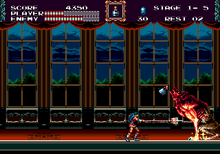Castlevania: Bloodlines
| Castlevania: Bloodlines | |
|---|---|
 North American box art | |
| Developer(s) | Konami |
| Publisher(s) | Konami |
| Producer(s) | Tomikazu Kirita |
| Designer(s) |
Teisaku Seki Shinichiro Shimamura |
| Composer(s) | Michiru Yamane |
| Series | Castlevania |
| Platform(s) | Sega Genesis |
| Release date(s) | |
| Genre(s) | Platform game |
| Mode(s) | Single-player |
Castlevania: Bloodlines, known as Vampire Killer (バンパイアキラー Banpaia Kirā) in Japan and as Castlevania: The New Generation in PAL regions, is a platform game developed and published by Konami for the Sega Genesis, released worldwide in March 1994. It was the only Castlevania video game released on the Genesis.
The game's storyline concerns a legendary vampire named Elizabeth Bartley who is Dracula's niece, suddenly appearing in the 20th century. Plotting a sacrificial war in order to bring her uncle back to life, she orchestrates the beginning of World War I. Quincy Morris' son, John, and his best friend Eric Lecarde, vow to take up the fight against evil. Together they manage to prevent Dracula's full resurrection.
Unlike most Castlevania games, Bloodlines was the first game in the series that does not take place exclusively in Dracula's castle, with most levels taking place throughout Europe.
Gameplay
As with most early Castlevania games, players proceed through each level, defeating enemies and collecting gems (hearts in previous games) to power special weapons (in this game, the axe, boomerang, and holy water). Each stage is sectioned, and has a sub-boss battle in the middle, with a main boss battle at the end. Some items will increase the power of the characters' weapons. Some portions of the game split into different paths, depending on which character is chosen. John is able to swing past huge gaps with his whip, whereas Eric must use a different route by performing high jumps by using his spear.
In addition to the first level (Dracula's castle in Romania), there are another five levels set in other European countries — Athens, Greece; Pisa, Italy; a weapon factory in Germany; the Palace of Versailles, in France; and the fictional Castle Proserpina in England.
Bloodlines is also noteworthy for its abundance of special effects, such as the Atlantis Shrine's water reflections, the swaying tower of Pisa, and large multi-jointed bosses. The final stage even uses effects to add challenge, such as playing upside-down or playing while the screen divides up into sections. The "Item Crash" feature (from Castlevania: Rondo of Blood) makes its return in Bloodlines.
Story

In 1897, the long war between humanity and Dracula came to an end, as Dracula was laid to eternal rest by Quincey Morris, a distant descendant of the Belmont family. Peace was restored to Europe, until the outbreak of the First World War, which transformed the continent into a dark world filled with massacre and violence. At the beginning of the war, in June 1914 at Sarajevo, the Crown Prince of Austria was assassinated. It was said that a strange beautiful woman was involved, within the shadows. It was Elizabeth Bartley (エリザベート・バートリー Erizabēto Bātorī). In order to revive her uncle, Count Dracula, she conducted an unholy ceremony which caused the war, giving her possession of human souls from Europe.
The game itself takes place in 1917. The characters are John Morris, a distant descendant of the famed Belmont and Morris families who obeyed his fate to fight vampires day and night, and Eric Lecarde, whose girlfriend was transformed into a vampire when Elizabeth was revived. After Drolta Tzuentes (ドロテア・ツェンテス Dorotea Tsentesu) resurrected Elizabeth Bartley, they traveled across Europe to conduct the resurrection of Count Dracula. John Morris and Eric Lecarde followed them. Even though the resurrection of Dracula was a success, the vampire hunters defeated him, and his allies.
Development
The game was originally released as a side story of Castlevania series.[1] Eric's facial features were more feminine (i.e., bishōnen) in the Japanese version. When brought to North America, his facial design was changed in the intro to seem more masculine. Oddly, although also changed for the European and Australian versions intro, his feminine face was kept for the cover of those releases.
Castlevania: Bloodlines underwent censorship during localization to PAL regions in Europe and Australia. The word blood was kept out of the title at the time. Therefore, the title was altered to Castlevania: The New Generation. When the game starts, the blood from the bottom of the title screen was changed to water. Another thing that was changed for the title screen is that the North American and Japanese versions had blood dripping effects from the title to the blood pool, but in the European version, the title screen just faded in through pixelated text and had no blue water dripping effect. The zombies were changed from pink to green to make them less gruesome. In the European version, Eric's spear does not impale him after he dies. There was a rearrangement of enemy placement as well, making the difficulty either easier or harder depending on where in the game the player is. Only some sub-bosses use the life bar meter to show damage, whereas others do not.
The packaging artwork for the North American and European versions was created by Tom Dubois, who also designed the packaging for many other Konami titles outside Japan.[2]
Audio
The music of Bloodlines was composed by Michiru Yamane, who later garnered acclaim for her score for Castlevania: Symphony of the Night and subsequent handheld Castlevania adventures. Though she once admitted to have worked under extreme pressure and deadlines,[3] this soundtrack met the standards of the previous entries and is highly regarded on its own for its gloomy atmosphere. The music for the second level, titled "The Sinking Old Sanctuary," was reused in later Castlevania games, Circle of the Moon, for the Game Boy Advance, and Legacy of Darkness, for the Nintendo 64.
The main themes for each of the first levels of the three NES Castlevania games (Vampire Killer, Bloody Tears, Beginning) are accessible in-game with a code, can be played in the sound test and one will be chosen randomly to play when the player obtains the maximum weapon power level. Also, Nothing to Lose (the Castle Keep theme for the NES Castlevania) was played in the final part of the first stage. Theme of Simon (from Super Castlevania IV) plays after defeating Elizabeth and before the battle with Dracula.
Reception
| Reception | ||||||
|---|---|---|---|---|---|---|
| ||||||
Bloodlines was an "instant hit" upon release.[5] GamesRadar named Castlevania: Bloodlines the 8th best Genesis game of all time out of a list of 25.[6] Game Informer's Tim Turi praised the level of gore relative to other Castlevania titles at the time. He also called it "one of the most overlooked treasures in the franchise."[7] GameZone ranked it as the fourth best Castlevania title.[5]
References
- ↑ Page 33, Rondo of Blood Strategy guide book
- ↑ Gidney, Adam. "Tom Dubois artist page". BOX=ART. Retrieved August 18, 2016.
- ↑ "It was my first title for the series ever, and I was under a lot a pressure." – Michiru Yamane, from the Castlevania: 20th Anniversary Deluxe Art Collection
- ↑ "Castlevania: Bloodlines for Genesis – GameRankings". GameRankings. Retrieved November 16, 2013.
- 1 2 Workman, Robert (2011-09-27). "Happy 25th Birthday Castlevania: The Ten Best Games in the Series". GameZone. Retrieved 2013-12-06.
- ↑ GamesRadar staff (April 17, 2012). "Best Sega Genesis games of all time". GamesRadar. Retrieved February 2, 2013.
- ↑ Turi, Tim (2012-04-04). "Ranking The Castlevania Bloodline". Game Informer. Retrieved 2013-12-05.
